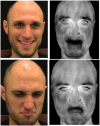Thermal expression of intersubjectivity offers new possibilities to human-machine and technologically mediated interactions
- PMID: 25101046
- PMCID: PMC4107845
- DOI: 10.3389/fpsyg.2014.00802
Thermal expression of intersubjectivity offers new possibilities to human-machine and technologically mediated interactions
Abstract
The evaluation of the psychophysiological state of the interlocutor is an important element of interpersonal relationships and communication. Thermal infrared (IR) imaging has proved to be a reliable tool for non-invasive and contact-less evaluation of vital signs, psychophysiological responses, and emotional states. This technique is quickly spreading in many fields, from psychometrics to social and developmental psychology; and from the touch-less monitoring of vital signs and stress, up to the human-machine interaction. In particular, thermal IR imaging promises to be of use for gathering information about affective states in social situations. This paper presents the state of the art of thermal IR imaging in psychophysiology and in the assessment of affective states. The goal is to provide insights about its potentialities and limits for its use in human-artificial agent interaction in order to contribute to a major issue in the field: the perception by an artificial agent of human psychophysiological and affective states.
Keywords: emotions; human–machine interaction; intersubjectivity; psychophysiology; thermal infrared imaging.
Figures


References
-
- Breazeal C. (2003). Emotion and sociable humanoid robots. Int. J. Hum. Comp. Stud. 59 119–155 10.1016/S1071-5819(03)00018-1 - DOI
-
- Bruce A., Nourbakhsh I., Simmons R. (2002). “The role of expressiveness and attention in human–robot interaction,” in Proceedings of the IEEE International Conference on Robotics and Automation, ICRA Washington, DC
-
- Buddharaju P., Dowdall J., Tsiamyrtzis P., Shastri D., Pavlidis I., Frank M. G. (2005). “Automatic Thermal Monitoring System (ATHEMOS) for Deception Detection,” in Proceedings of the IEEE Computer Society Conference on Computer Vision and Pattern Recognition Vol. 2 (Washington, DC: IEEE Computer Society; ) 1179
LinkOut - more resources
Full Text Sources
Other Literature Sources

